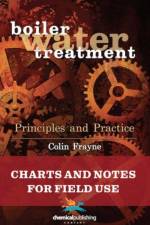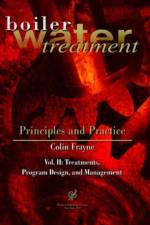- Charts and Notes for Field Use
von Colin Frayne
124,00 €
Table of Contents:About the Author - Saturated steam temperatures at various boiler pressures - Boiler Energy and Power Units - Typical gross heating values of common fuels (based on approximately 80% fuel to steam efficiency) - Typical energy consumption and output ratings for a fire tube boiler - Steam tables suitable for pressure deaerators - Calculating Blowdown - Coefficients of thermal conductivity for some heat-exchanger metals and boiler deposits - Types of water or steam commonly employed in most HW heating and steam generating plants - Commonly occurring minerals in natural MU water sources - Specific waterside / steamside problems affecting MPHW and HPHW boiler plants - Salt concentration indicators - Summary of waterside / steamside problems affecting LPHW and LP steam heating boiler plants - FW contamination from MU water - FW contamination from returned condensate - Problems associated with the final FW blend - Deposition of boiler section waterside surfaces by alkaline earth metal salts, other inorganic salts and organics - Silica and silicate crystalline scales and deposits affecting boiler section waterside surfaces - Iron oxide and other boiler section corrosion debris deposits - Boiler section corrosion problems involving oxygen, concentration cells and low pH - Stress and high temperature related corrosion - Steam purity, quality and other operational problems - Specification for grades of high-quality water suitable for higher pressure WT boilers - Practical considerations for a RW ion-exchange softener - Types of Internal Treatment Program - Carbonate Cycle Requirement Calculations - Phosphate-Cycle Requirement Calculations - A Guide to Tannin Residuals in BW - Carbonate-Cycle Program. BW Carbonate Reserve Requirements by Pressure and Sulfate Concentration - Carbonate-Cycle Coagulation and Precipitation Program. Recommended BW Control Limits for Non-Highly-Rated FT Boilers Employing Hard or Partially Softened FW - Phosphate-Cycle Coagulation and Precipitation Program. Recommended BW Control Limits for Non-Highly-Rated FT Boilers Employing Hard, Partially Softened, or Fully Softened FW - Phosphate-Cycle Coagulation and Precipitation Program. Recommended BW Control Limits for Non-Highly-Rated WT Boilers Employing Hard, Partially Softened, or Fully Softened FW - Chelant demand (ppm product) per 1ppm substrateEDTA Chelant or All-Polymer/All-Organic Program. Recommended BW Control Limits for Fired WT Boilers Employing Demineralized or Similar Quality FW - Oxygen Solubility at Atmospheric Pressure - Properties of Oxygen Scavengers - Carbon Dioxide Evolution from FW Alkalinity - Amine Requirement to Reach a Stable Condensate pH - Amine Basicity Dissociation Constants - Neutralizing Amine Summary Notes - Some DR values for CO2, NH3 and neutralizing amines at various pressures - Calculating Alkalinity Feed-Rate Requirements - [ASME Consensus table 1: Suggested water chemistry limits. Industrial watertube, high duty, primary fuel fired, drum typeMakeup water percentage: Up to 100% of feedwater. Conditions: Includes superheater, turbine drives or process restriction on steam purity] - [ASME Consensus table 2: Suggested chemistry limits. Industrial watertube, high duty, primary fuel fired, drum type] - [ASME Consensus table 3: Suggested chemistry limits. Industrial firetube, high duty, primary fuel fired] - [ASME Consensus table 4: Suggested water chemistry limits. Industrial coil type, watertube, high duty, primary fuel fired rapid steam generators] - [ASME Consensus table 5: Suggested water chemistry limits. Marine propulsion, watertube, oil fired drum type] - [ASME Consensus table 6: Suggested water chemistry limits. Electrode, high voltage, forced circulation jet type] - Notes




